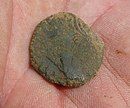Porta Westfalica Roman camp

The Roman camp Porta Westfalica (also: Roman camp Barkhausen ) was a Roman military camp from Augustan times on the left bank of the Weser , which served as a marching camp for Roman troops. It is located in the Barkhausen district of the East Westphalian town of Porta Westfalica in the Minden-Lübbecke district . It was discovered in 2008 and archaeologically investigated in the following years, with evidence that the site was used as a burial ground from the Bronze Age to the Early Middle Ages .
location
The area of the Roman camp is located west of the Weser in Barkhausen on a flat terrace. Immediately south of it, the river coming from the south leaves the Weserbergland and flows north into the North German Plain . It breaks through the Weser and Wiehen Mountains and forms the Porta Westfalica , through which traffic routes have led since prehistoric times. Correspondingly, excavations have found human traces from the Bronze Age to recent history. Today the area is completely built over.
Excavations and finds
The marching camp was discovered in July 2008 during investigations prior to the development of a building area "Auf der Lake" in the middle of a residential area. It was the only larger, undeveloped area in town. The discovery was made through the discovery of a Roman Aucissa fibula and a coin from the Celtic tribe of the Remer , whose members served as auxiliary troops in the Roman army . As early as 1950, a Roman gold coin from the Augustan era was discovered about 150 meters away.
The Bielefeld branch of the LWL Archeology for Westphalia began excavations in 2008 with the participation of volunteer probe-goers . The excavations on an area of 30,000 m² lasted until 2011 and brought to light 878 findings as well as a large number of finds from the Bronze Age to the Early Modern Age . The large number of finds suggests that the place was used as a storage place at different times due to the traffic routes.
The finds from the Augustan era include tent pegs, shoe nails from legionnaires' sandals, ten fibulas, the clasp of chain mail, lead plumb bobs for measuring the terrain as well as a javelin tip and two lance tips. 60 Roman and Celtic coins were found, showing two time horizons. At the time of the Drusus campaigns from 12 to 9 BC. One Gaulish small bronze of the Remer and eight coins minted in Gaul show. Characteristic of the period after the birth of Christ are two Gaius - Lucius - denarii , eleven embossed in Lyon and Rome coins and four Celtic bronzes.
The remains of 30 Roman field ovens made of clay were located in the area. A V-shaped ditch typical of Roman marching camps could not be discovered.
The finds indicate the presence of Roman troops during the Augustan Teutonic Wars , i.e. from 12 BC. To 16 AD, up. It is assumed that the camp was not permanently occupied, but only served as a temporary residence.
The Regional Association of Westphalia-Lippe suspected that the Roman general Varus had stayed in the camp before he went into battle. The location matches the historical sources. The distance from the Roman Lippe camps to Kalkriese is also plausible. The Roman camp Porta Westfalica could be reached in two days from the Roman camp Bielefeld-Sennestadt, which was discovered in 2017 .
- Found objects
Finds from other eras
During the excavations, finds from other eras were made. These include a. an urn grave field from the first millennium BC, ceramic remains from the pre-Roman Iron Age , a long ax from the time of Charlemagne , a fibula from the 9th century and a silver coin from 1621.
literature
- Werner Best: Romans and more. In: Denkmal-Zeitung. September 13, 2009, published by the LWL Office for Monument Preservation in Westphalia . (PDF p. 9)
- Bettina Tremmel : Augustan marching camp in Porta Westfalica-Barkhausen . In: Archeology in Westphalia-Lippe 2009. Published by the LWL-Archeologie für Westfalen and the Antiquities Commission for Westphalia. (PDF)
- Hannelore Kröger, Werner Best: Porta Westfalica - Barkhausen: A walk through the millennia . Published by the Förderverein Römerlager Barkhausen Porta Westfalica eV in cooperation with the LWL - Archeology for Westphalia. (PDF)
Web links
- Roman camp Porta on the website of the Förderverein Römerlager Barkhausen Porta Westfalica
- Roman camp Porta Westfalica at vici.org
Individual evidence
- ↑ Denarius of Augustus with a representation of Caesares Gaius and Lucius
- ↑ Archaeologists find the Roman general's camp in Spiegel Online from August 7, 2008
Coordinates: 52 ° 15 ′ 25.6 " N , 8 ° 54 ′ 43.7" E








